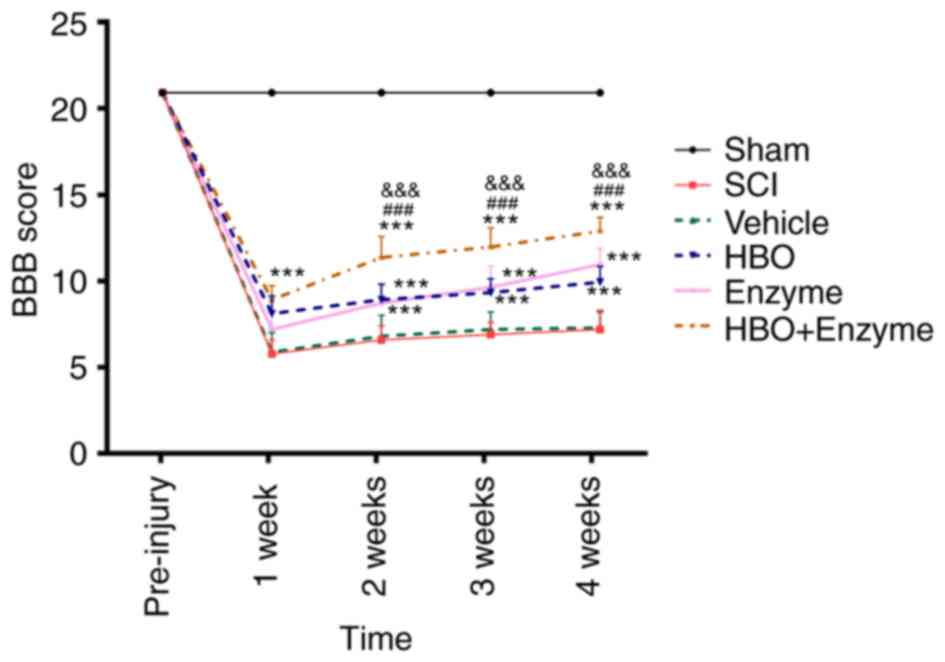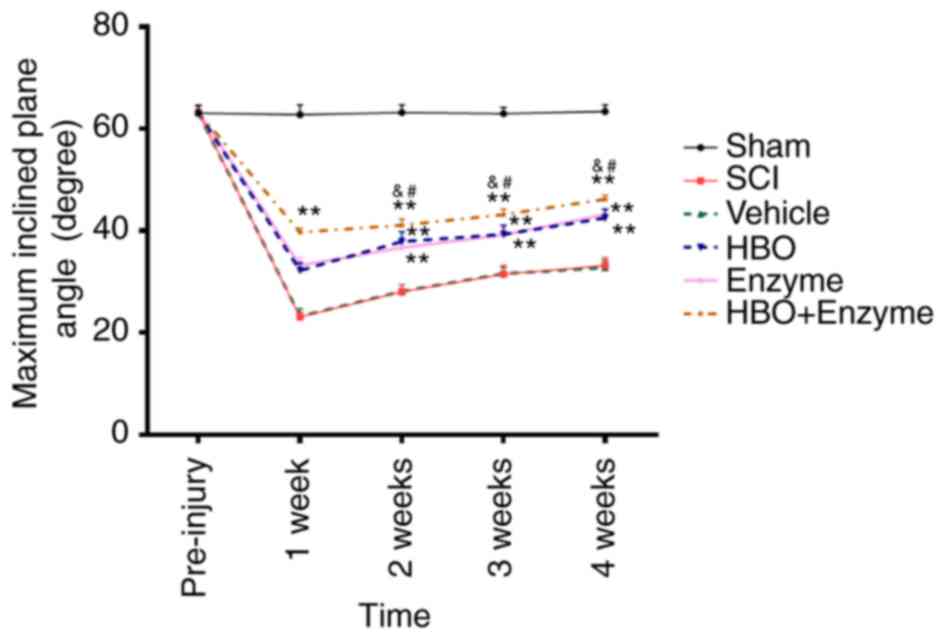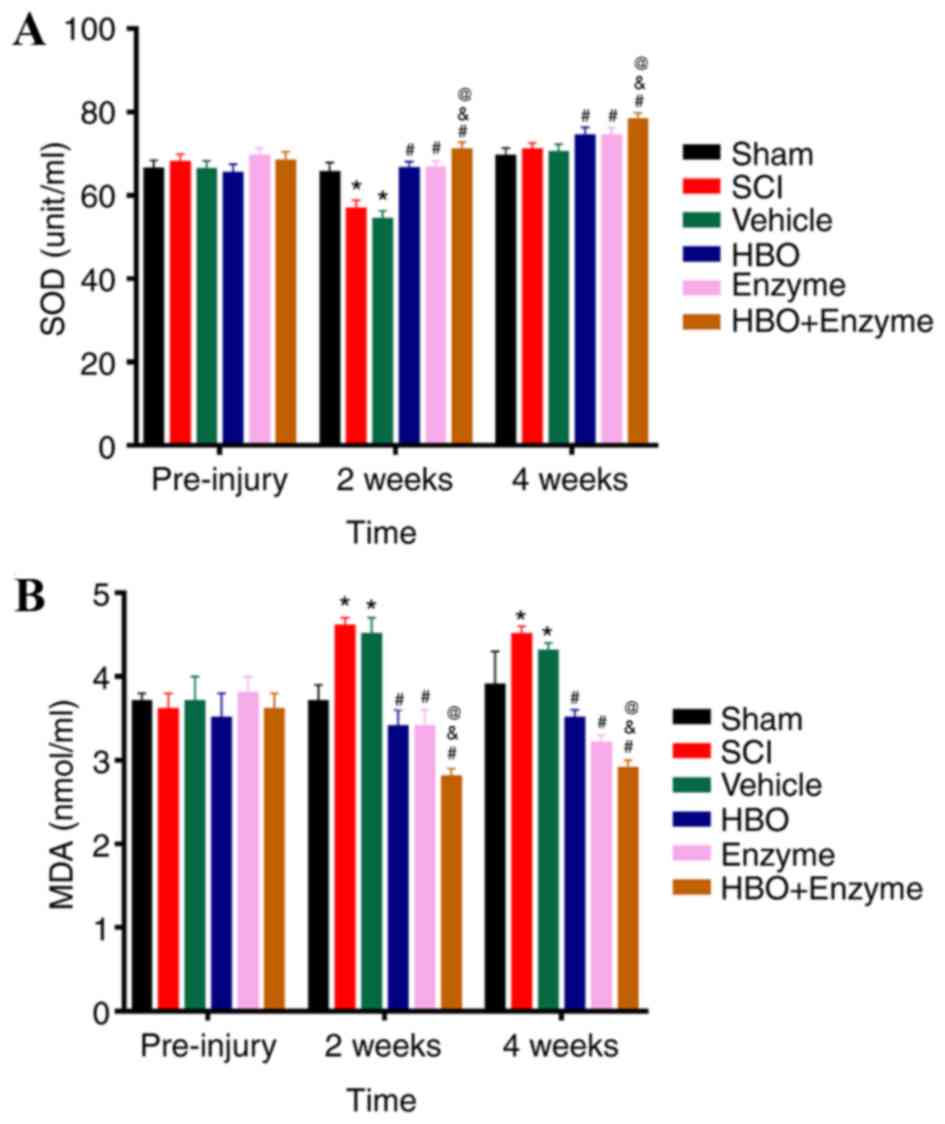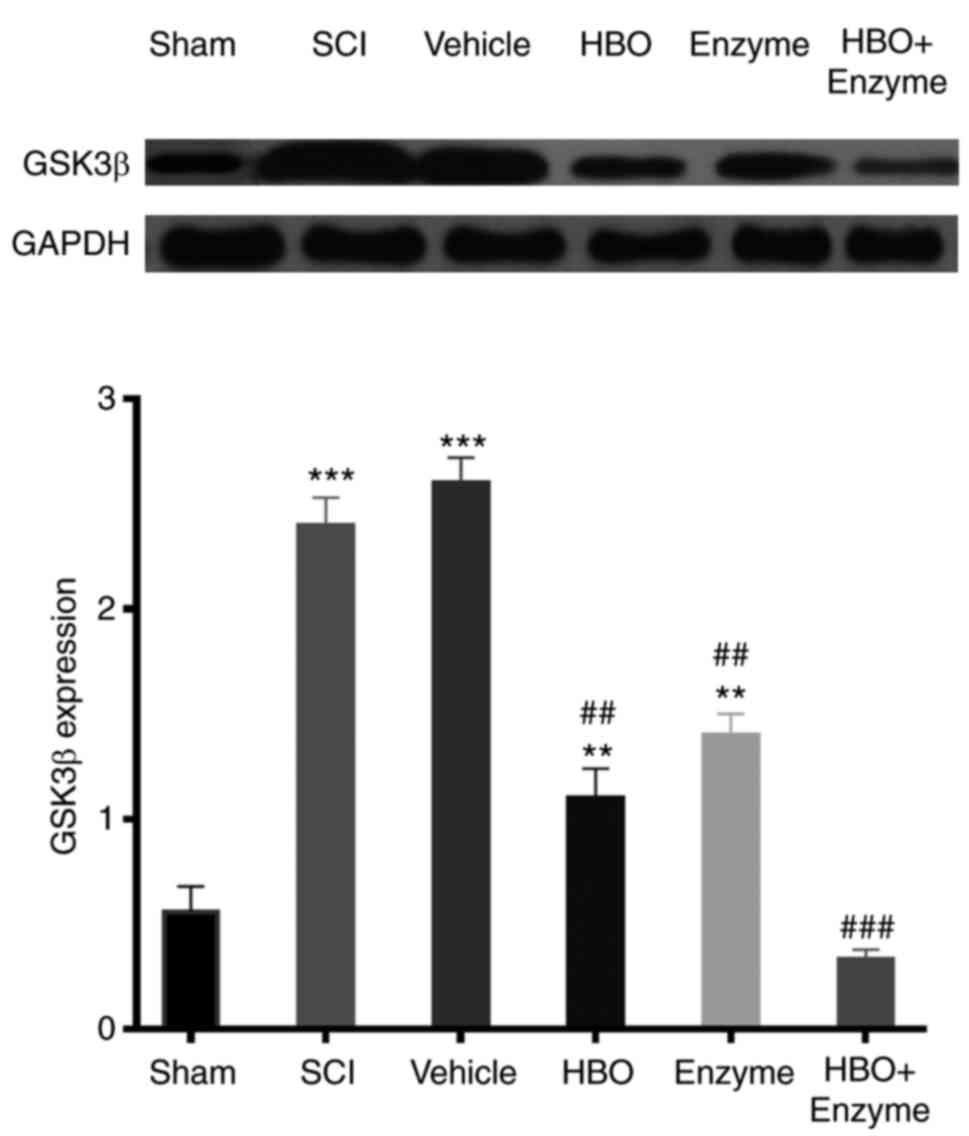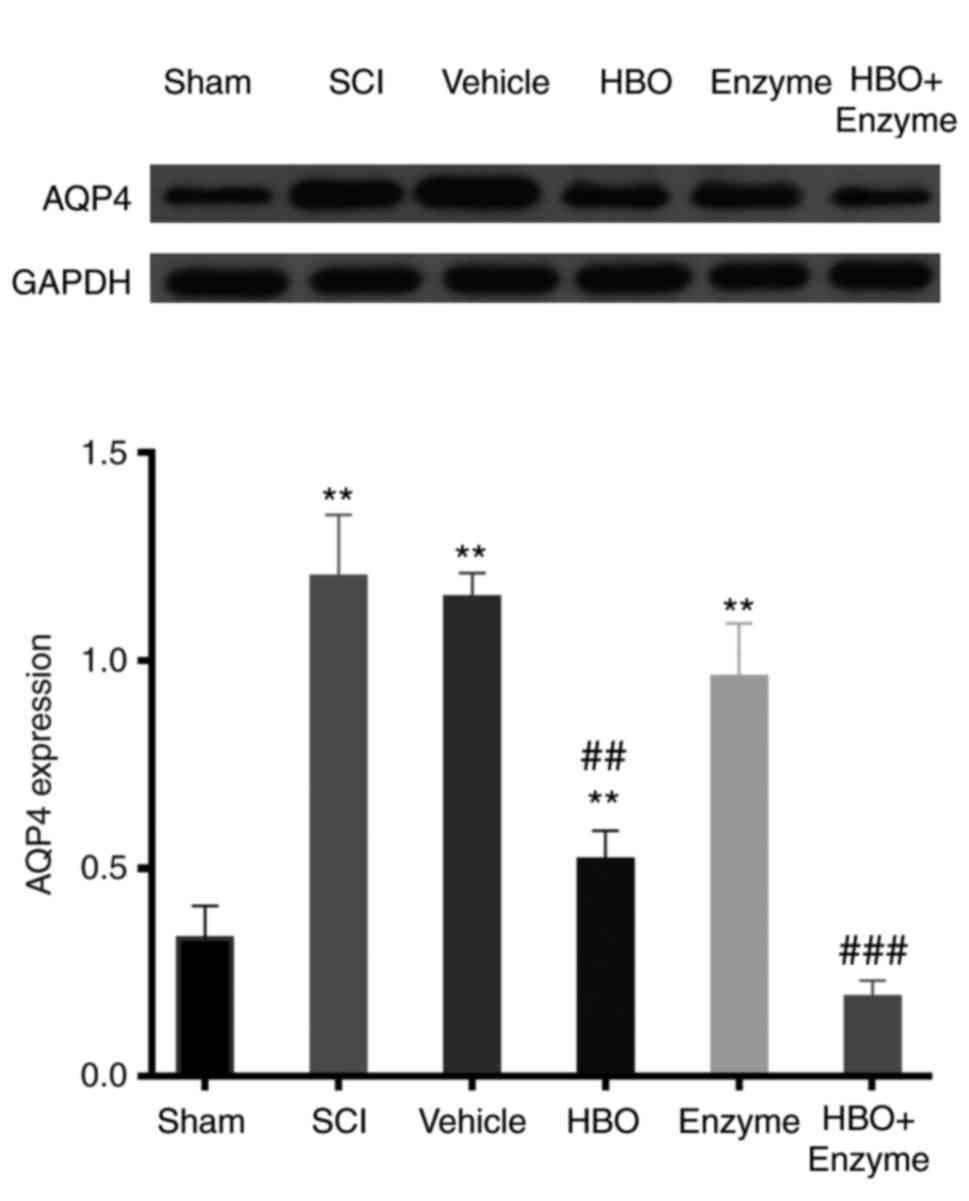Effect of combined chondroitinase ABC and hyperbaric oxygen therapy in a rat model of spinal cord injury
- Authors:
- Published online on: April 26, 2018 https://doi.org/10.3892/mmr.2018.8933
- Pages: 25-30
-
Copyright: © Liu et al. This is an open access article distributed under the terms of Creative Commons Attribution License.
Abstract
Introduction
Spinal cord injury (SCI) often leads to paralysis, has a high morbidity rate and occurs in both genders equally (1,2). A series of pathophysiological responses lead to progressive spinal cord tissue degeneration and necrosis following SCI. It is thought this is due to microcirculation disorder and neuronal biochemical imbalances involving prostaglandins, calcium, neurotransmitters and free radicals (3). Despite numerous advances in medical science, no definitive treatment for SCI has been developed. Ongoing research aiming to resolve this issue has proposed various treatment options including medicinal, cell and gene therapies (4–6). The lack of success observed in this research may be attributed to the complicated pathophysiology of SCIs and associated factors. For example, the inhibiting factor chondroitin sulfate proteoglycan (CSPG) is associated with glial scars and is thought to limit the effectiveness of SCI treatment (7,8).
It has been proposed that the primary factors influencing the outcome of patients with SCI are glial scarring and chronic inflammation (9,10). CSPG is an extracellular matrix molecule that is expressed following SCI and reaches its maximal expression two weeks following injury (11). CSPG activates a cascade that leads to the activation of glycogen synthase kinase-3β (GSK3β), a key factor in the inhibition of tissue and axon recovery in the central nervous system (12). Chondroitinase ABC (ChABC) is an enzyme produced by the bacteria Proteus vulgaris that cleaves disaccharides and tetrasaccharides (13). It was demonstrated that the digestion of glycosaminoglycan (GAG) by ChABC may enhance axonal regeneration and improve neuromotor function following SCI (14,15). A loss of GAG occurs in intervertebral disc degeneration and thus, the injection of ChABC may be used to construct a model of this condition (16). ChABC administration following SCI has moderate efficacy and its effectiveness may be improved by the simultaneous administration of other medications (17–20).
Previous studies have demonstrated that lipid oxidation by free radicals has important implications in the outcome of SCI (3,21). Certain reports suggest that hyperbaric oxygen (HBO) treatment induces GAG synthesis, which reduces oxygen free radical generation in the body and subsequently reduces lipid oxidation and promotes SCI repair. However, other studies have concluded the opposite (16,22–24). Therefore, the effect of HBO on nerve injury is not fully understood. A previous study demonstrated that HBO may protect Sprague-Dawley rats induced by ChABC treatment from intervertebral disc degeneration (16). However, less is known about the combined effect of HBO and ChABC therapy in a rat model of SCI. In the present study, the efficacy of simultaneous HBO and ChABC treatment in rats following SCI was examined. Serum malondialdehyde (MDA) and superoxide dismutase (SOD) levels were examined to evaluate the extent of lipid peroxidation in injured cells (21).
Materials and methods
Experimental animals
The Ethics Committee of the Yantai Yuhuangding Hospital (Yantai, China) approved the protocol of animal care and handling in the present study. A total of 48 healthy male Wistar rats (150–170 g) were provided by The Experimental Animal Center of Shandong University (Jinan, China). Rats had free access to food and water and were housed together in a 12 h light/dark cycle at 25°C and 75% relative humidity, in specific pathogen-free conditions. Rats were randomly divided into six groups (Table I).
Experimental SCI model
The experimental SCI model was induced in rats using the clip compression method (18,25). Rats were anesthetized by intraperitoneal injection of ketamine (80 mg/kg) and xylasine (10 mg/kg). The laminectomy was performed at the T13-L1 level following skin and muscle incision. The spinal cord was compressed by a microvascular clip (Fine Science Tools GmbH, Heidelberg, Germany) that induced 20 g/cm2 pressure for 90 sec. Animals were monitored for 4 weeks following surgery.
HBO treatment
HBO treatment began 2 h following SCI establishment and was continued once daily for 14 days. A medical hyperbaric oxygen chamber (Ningbo Hyperbaric Oxygen Corporation, Ningbo, China) was prepared with a flush of pure oxygen for 10 min. SCI-HBO rats were placed into the HBO chamber and exposed to 80% oxygen at 0.3 MPa (3 ATA) for 60 min, followed by depressurization for 30 min. Control animals were treated with regular air.
ChABC injection
The injury site was re-exposed in anesthetized rats 7 days following surgery and ChABC (0.1 U/µl; total, 10 µl; Sigma-Aldrich, Merck KGaA, Darmstadt, Germany) diluted in 0.01% bovine serum albumin (Gibco; Thermo Fisher Scientific, Inc., Waltham, MA, USA) and PBS was slowly intraspinally injected over 2 min using a 30 µm glass micropipette connected to a Hamilton syringe (depth, 1 mm), 2 mm rostral to injury site (18). The needle was kept in the injection site for 1 min following the termination of the injection to prevent backflow.
Neuromotor function assessment
The Basso-Beattie-Bresnahan (BBB) locomotor rating scale (26) and the inclined plane assessment were used to examine neuromotor function prior to surgery and for 4 weeks thereafter (26). For the inclined plane assessment, the inclination angle of the board is freely adjustable. The maximum inclination angle of the board on which the rat stayed for 5 sec without falling off was recorded (27). The BBB rating scale has a range of 0–21 points, judged by parameters including the coordination of limb movement, paw placement and tail balance. No visible movement of the hind legs was scored as zero points. For the maximum 21 points, the rat had to walk continuously on its paws, with a cocked tail, good fore and hind limb motor coordination and trunk stability. Data was quantified as the average score of the two hind limbs.
SOD and MDA assays
Tail blood (1.5 ml) was obtained at 0, 2 and 4 weeks following SCI. SOD activity was measured using the xanthine oxidase assay (cat no. A001-1-1; Nanjing Jiancheng Bioengineering Institute, Nanjing, China) and MDA levels were detected using the thiobarbituric acid assay (cat no. A003-4; Nanjing Jiancheng Bioengineering Institute), according to the manufacturer's protocols.
Western blot analysis
Following the removal of the dura, spinal cord (100–300 µg) from the T13-L1 level was homogenized on ice in radioimmunoprecipitation assay lysis buffer (Beyotime Institute of Biotechnology, Haimen, China). Protein concentration was measured with a Nano dropper (Thermo Fisher Scientific, Inc.). The proteins (25 µg/lane) were electrophoresed on 10% SDS-PAGE gel for 1 h at 120 V and subsequently transferred to polyvinylidene difluoride membranes (EMD Millipore, Billerica, MA, USA). The blots were blocked with 5% non-fat dry milk for 1 h at 37°C prior to incubation with the primary antibodies rabbit polyclonal anti-aquaporin 4 (AQP4; 1:100; catalog no. ab46182; Abcam, Cambridge, UK) and rabbit polyclonal anti-GSK3β (1:100; catalog no. ab15314, Abcam) overnight at 4°C. Following incubation with horseradish peroxidase-conjugated goat anti-rabbit secondary antibody (1:1,000; cat no. A0208; Beyotime Institute of Biotechnology) for 1 h at 37°C, the protein bands were visualized using the chemiluminescence substrate kit (Beyotime Institute of Biotechnology). GAPDH (1:2,000; cat no. sc-69778; Santa Cruz Biotechnology, Inc., Dallas, TX, USA) was used as an internal control. Densitometry analysis performed using the Image J software version 1.3 (National Institutes of Health, Bethesda, MD, USA).
Statistical analysis
All data is presented as the mean ± standard error. Statistical analyses were performed with SPSS software 15.0 (SPSS, Inc., Chicago, IL, USA). Data were analyzed using the two-sided repeated measures analysis of variance with the Bonferroni post-hoc test. P<0.05 was considered to indicate a statistically significant difference.
Results
Hind limb neuromotor function assessment
The BBB locomotor rating scale and the inclined plane assessment were used to assess the hind limb neuromotor function, which is an important index for SCI (26). Prior to establishment of the SCI, rats in all groups had a baseline BBB score of 21 points. Following SCI, the BBB score was significantly decreased in all groups compared with the control rats (P<0.0001), indicating that motor functions were reduced following SCI. During the 4 week follow up, a certain degree of motor function recovery was observed, however the baseline level was not recovered. Sham rats had a BBB score of 21 throughout the study (Fig. 1).
The BBB score in the combination therapy group (HBO + enzyme group) was significantly increased compared with the SCI rats 1 week following SCI establishment (P<0.001). At week 2, 3 and 4, the BBB score was increased in the HBO, enzyme and HBO + enzyme groups compared with the SCI group (P<0.001). The BBB score increase in the HBO + enzyme group was significantly greater compared with the HBO and enzyme groups at week 2 (P<0.001), 3 (P<0.001) and 4 (P<0.001).
For the inclined plane assessment, rats in all groups achieved a maximum angle of ~63° prior to SCI establishment. The maximum inclination angles were significantly reduced and subsequently increased at 2, 3 and 4 weeks in all groups following SCI (P<0.01). The maximum angle in the HBO + enzyme, HBO and enzyme groups were significantly increased compared with the SCI group (P<0.01). The angle in the HBO + enzyme group was significantly increased compared with the HBO and enzyme groups (P<0.05; Fig. 2). Therefore, the combination of HBO and ChABC significantly improved the motor function recovery following SCI compared with HBO or ChABC treatment alone.
Serum SOD and MDA content
To detect alterations in the generation of oxygen free radicals, serum SOD and MDA levels were detected. Following SCI, serum SOD levels were significantly decreased and serum MDA levels were significantly increased compared with the sham group. Serum SOD activity in HBO + enzyme, HBO and enzyme groups were significantly increased compared with sham and SCI rats 2 weeks following SCI (Fig. 3A). Conversely, MDA levels were significantly decreased in the HBO + enzyme, HBO and enzyme groups compared with the sham and SCI groups (Fig. 3B). SOD and MDA levels in HBO + enzyme group were respectively increased or decreased compared with HBO and enzyme groups 2 and 4 weeks following SCI establishment. There was no significant alteration in SOD or MDA levels in the HBO and enzyme groups at 2 or 4 weeks.
GSK3β expression in the spinal cord
GSK3β is involved in the prevention of axon regeneration following SCI (19,28). Western blot analysis indicated that GSK3β expression was significantly upregulated compared with baseline following SCI establishment (P<0.001) 4 weeks post-surgery. HBO (P<0.01), enzyme (P<0.01) and HBO + enzyme (P<0.001) treatments all significantly inhibited GSK3β expression. The combination of HBO and ChABC reduced GSK3β expression to sham rat expression levels, indicating that this combination may be effective in improving the outcome of SCI (Fig. 4).
Assessment of AQP4 expression in the spinal cord
Increased AQP4 expression impedes SCI recovery (29,30). Western blot analysis determined that AQP4 expression was significantly increased compared with the sham group following SCI establishment (P<0.001). HBO (P<0.01) and HBO + enzyme (P<0.001) treatment significantly inhibited the expression of AQP4 compared with the SCI group. The enzyme treatment alone did not significantly inhibit the expression of AQP4 compared with the SCI group. The strongest inhibition of AQP4 expression was observed in the HBO + enzyme treatment group (Fig. 5).
Discussion
In the present study, the therapeutic effects of HBO and ChABC administrated alone and in combination in SCI rats was examined. The combination of HBO and ChABC was demonstrated to have the most beneficial effects on BBB scores, motor function recovery and the expression of SOD, MDA, GSK3β and AQP4, compared with the administration of either treatment alone.
Lipid peroxidation and the extent of neuronal damage may be assessed by the detection of inflammatory mediators, including SOD and MDA (21). SOD is a naturally occurring neuroprotective free radical scavenger that converts harmful superoxide radicals into hydrogen peroxide. MDA is a key product of membrane lipid peroxidation, which is involved in the mitochondrial respiratory chain complex and exacerbates damage to the membrane. In the present study, HBO treatment significantly improved neuromotor function compared with the sham and SCI rats, suggesting an increase in SOD activity and reduced lipid peroxidation by oxygen free radicals. This indicates that oxygen free radical inhibition may be one of the mechanisms by which HBO treatment improves neuromotor function in SCI rats.
There are two primary obstacles that impede recovery following SCI: The expression of inflammatory factors and the production of CSPG (31). A direct correlation exists between the production of inflammatory cytokines and CSGP (31). In SCI, CSGP is involved in processes of cell death, demyelination, cavitation, microglial invasion and eventually the impairment of neuromotor function (14,15). Inflammation is associated with an increase in GSK3β expression in SCI (28,32). GSK3β is involved in the induction of demyelination and Wallerian degeneration (12,28). GSK3β also regulates the production of CSGP and thus prevents axonal regeneration following SCI (19,28). Increased CSGP expression may also contribute to neuromotor function impairment through the disruption of axonal connections and axonal regeneration (28). All these mechanisms may be involved in the BBB decrease observed in SCI rats and the recovery of neuromotor function following HBO + enzyme treatment in the present study. ChABC enzyme administration may directly overcome the endothelial barrier through the degradation of CSPG (33), thus creating a permeable environment that allows axonal regeneration (34,35). A previous study indicated that enzyme secretion begins within a day of injury and reaches its maximum expression following 1 week (11). Therefore, the enzyme was injected 1 week following SCI establishment. ChABC may exhibit anti-inflammatory properties (36). The results of the current study revealed that GSK3β expression decreased in the combined treatment and that neuromotor function following SCI was improved, which is indicative of reduced demyelination and axonal regeneration (32,37). The combined HBO and ChABC treatment may have created a permeable environment by decreasing CSPG and GSK3β to promote neuromotor function.
Previous studies have demonstrated that local edema occurs immediately following SCI, due to endothelial barrier permeability injury (38,39). Microglial invasion and inflammatory cytokine production increases, leading to cell death, demyelination, cavity formation, paralysis and even mortality (40,41). AQP4 may reduce edema by facilitating the excretion of excessive water (42). However, increased AQP4 expression in the chronic stage of SCI may be indicative of continued water retention and cytotoxic edema that impedes recovery (29,30). A previous study suggested that the role of HBO in the dysregulation of blood-brain barrier permeability should be taken into consideration when patients are exposed to HBO (43). Additionally, Wang et al (16) reported that HBO therapy significantly suppresses the decrease in disc height caused by ChABC injection, suggesting that HBO may protect the intervertebral discs against ChABC-induced injury. Consistent with these results, the present study demonstrated that combined HBO and ChABC therapy exerted a protective effect in the SCI rat model. Although alterations in the permeability of the spinal cord vasculature were not directly detected, to the best of the author's knowledge, the present study is the first to demonstrate the combined effect of ChABC and HBO in SCI. It was revealed that the expression of AQP4 in SCI rats was not significantly decreased by ChABC alone, indicating cytotoxic edema may be a limitation for this treatment. Results also indicated that HBO may protect against permeability barrier destruction by ChABC, however this conclusion should be validated with further research. The association of HBO with ChABC is still unclear and further investigation of the molecular mechanisms and associated signaling pathways are required.
In conclusion, the results of the present study demonstrated that although the application of HBO and ChABC alone reduced the GSK3β level and improved neuromotor recovery in SCI model rats, ChABC alone did not inhibit the induction of AQP4 expression following SCI, which may be a limitation to this treatment. In the combined treatment group, the expression of GSK3β and AQP4 was returned to baseline and the recovery of neuromotor function was improved. Increased serum SOD activity and decreased serum MDA content indicated a potential role of oxygen free radicals in the pathophysiological consequences of SCI. These alterations were reversed by the combined HBO and ChABC treatment. Therefore, the combined treatment was concluded to be more effective than application of either treatment alone. Improved neuromotor function was likely due to a reduction in inflammation by ChABC and HBO, as well as the degradation of CSPG by ChABC which contributes to the preservation of tissue integrity. Future studies should aim to further understand the underlying mechanisms.
References
|
Jackson A: Spinal-cord injury: Neural interfaces take another step forward. Nature. 539:177–178. 2016. View Article : Google Scholar : PubMed/NCBI | |
|
Ropper AE and Ropper AH: Acute spinal cord compression. N Engl J Med. 376:1358–1369. 2017. View Article : Google Scholar : PubMed/NCBI | |
|
Hall ED: Lipid antioxidants in acute central nervous system injury. Ann Emerg Med. 22:1022–1027. 1993. View Article : Google Scholar : PubMed/NCBI | |
|
Ajiboye AB, Willett FR, Young DR, Memberg WD, Murphy BA, Miller JP, Walter BL, Sweet JA, Hoyen HA, Keith MW, et al: Restoration of reaching and grasping movements through brain-controlled muscle stimulation in a person with tetraplegia: A proof-of-concept demonstration. Lancet. 389:1821–1830. 2017. View Article : Google Scholar : PubMed/NCBI | |
|
Capogrosso M, Milekovic T, Borton D, Wagner F, Moraud EM, Mignardot JB, Buse N, Gandar J, Barraud Q, Xing D, et al: A brain-spine interface alleviating gait deficits after spinal cord injury in primates. Nature. 539:284–288. 2016. View Article : Google Scholar : PubMed/NCBI | |
|
Lebedev MA and Nicolelis MA: Brain-machine interfaces: From basic science to neuroprostheses and neurorehabilitation. Physiol Rev. 97:767–837. 2017. View Article : Google Scholar : PubMed/NCBI | |
|
Bagherzadeh K, Maleki M, Golestani A, Khajeh K and Amanlou M: Chondrotinase ABC I thermal stability is enhanced by site-directed mutagenesis: A molecular dynamic simulations approach. J Biomol Struct Dyn. 1–10. 2017. | |
|
Rauvala H, Paveliev M, Kuja-Panula J and Kulesskaya N: Inhibition and enhancement of neural regeneration by chondroitin sulfate proteoglycans. Neural Regen Res. 12:687–691. 2017. View Article : Google Scholar : PubMed/NCBI | |
|
Yuan YM and He C: The glial scar in spinal cord injury and repair. Neurosci Bull. 29:421–435. 2013. View Article : Google Scholar : PubMed/NCBI | |
|
Muramoto A, Imagama S, Natori T, Wakao N, Ando K, Tauchi R, Hirano K, Shinjo R, Matsumoto T, Ishiguro N and Kadomatsu K: Midkine overcomes neurite outgrowth inhibition of chondroitin sulfate proteoglycan without glial activation and promotes functional recovery after spinal cord injury. Neurosci Lett. 550:150–155. 2013. View Article : Google Scholar : PubMed/NCBI | |
|
Jones LL, Margolis RU and Tuszynski MH: The chondroitin sulfate proteoglycans neurocan, brevican, phosphacan, and versican are differentially regulated following spinal cord injury. Exp Neurol. 182:399–411. 2003. View Article : Google Scholar : PubMed/NCBI | |
|
Dill J, Wang H, Zhou F and Li S: Inactivation of glycogen synthase kinase 3 promotes axonal growth and recovery in the CNS. J Neurosci. 28:8914–8928. 2008. View Article : Google Scholar : PubMed/NCBI | |
|
Akbari M, Khaksari M, Rezaeezadeh-Roukerd M, Mirzaee M and Nazari-Robati M: Effect of chondroitinase ABC on inflammatory and oxidative response following spinal cord injury. Iran J Basic Med Sci. 20:806–812. 2017.PubMed/NCBI | |
|
Cheng CH, Lin CT, Lee MJ, Tsai MJ, Huang WH, Huang MC, Lin YL, Chen CJ, Huang WC and Cheng H: Local delivery of high-dose chondroitinase ABC in the sub-acute stage promotes axonal outgrowth and functional recovery after complete spinal cord transection. PLoS One. 10:e01387052015. View Article : Google Scholar : PubMed/NCBI | |
|
Graham JB and Muir D: Chondroitinase C selectively degrades chondroitin sulfate glycosaminoglycans that inhibit axonal growth within the endoneurium of peripheral nerve. PLoS One. 11:e01676822016. View Article : Google Scholar : PubMed/NCBI | |
|
Wang IC, Liu HT, Yu CM, Whu SW, Lin SS, Su CI, Chen CH and Chen WJ: Effect of hyperbaric oxygenation on intervertebral disc degeneration: An in vivo study with sprague-dawley rats. Spine (Phila Pa 1976). 38:E137–E142. 2013. View Article : Google Scholar : PubMed/NCBI | |
|
Alluin O, Delivet-Mongrain H, Gauthier MK, Fehlings MG, Rossignol S and Karimi-Abdolrezaee S: Examination of the combined effects of chondroitinase ABC, growth factors and locomotor training following compressive spinal cord injury on neuroanatomical plasticity and kinematics. PLoS One. 9:e1110722014. View Article : Google Scholar : PubMed/NCBI | |
|
Janzadeh A, Sarveazad A, Yousefifard M, Dameni S, Samani FS, Mokhtarian K and Nasirinezhad F: Combine effect of Chondroitinase ABC and low level laser (660 nm) on spinal cord injury model in adult male rats. Neuropeptides. 65:90–99. 2017. View Article : Google Scholar : PubMed/NCBI | |
|
Sarveazad A, Babahajian A, Bakhtiari M, Soleimani M, Behnam B, Yari A, Akbari A, Yousefifard M, Janzadeh A, Amini N, et al: The combined application of human adipose derived stem cells and Chondroitinase ABC in treatment of a spinal cord injury model. Neuropeptides. 61:39–47. 2017. View Article : Google Scholar : PubMed/NCBI | |
|
Xia T, Huang B, Ni S, Gao L, Wang J, Wang J, Chen A, Zhu S, Wang B, Li G, et al: The combination of db-cAMP and ChABC with poly(propylene carbonate) microfibers promote axonal regenerative sprouting and functional recovery after spinal cord hemisection injury. Biomed Pharmacother. 86:354–362. 2017. View Article : Google Scholar : PubMed/NCBI | |
|
Hall ED: Inhibition of lipid peroxidation in CNS trauma. J Neurotrauma. 8 Suppl 1:S31–S41. 1991.PubMed/NCBI | |
|
Dayan K, Keser A, Konyalioglu S, Erturk M, Aydin F, Sengul G and Dagci T: The effect of hyperbaric oxygen on neuroregeneration following acute thoracic spinal cord injury. Life Sci. 90:360–364. 2012. View Article : Google Scholar : PubMed/NCBI | |
|
Geng CK, Cao HH, Ying X, Zhang HT and Yu HL: The effects of hyperbaric oxygen on macrophage polarization after rat spinal cord injury. Brain Res. 1606:68–76. 2015. View Article : Google Scholar : PubMed/NCBI | |
|
Thompson CD, Zurko JC, Hanna BF, Hellenbrand DJ and Hanna A: The therapeutic role of interleukin-10 after spinal cord injury. J Neurotrauma. 30:1311–1324. 2013. View Article : Google Scholar : PubMed/NCBI | |
|
Rong H, Liu Y, Zhao Z, Feng J, Sun R, Ma Z and Gu X: Further standardization in the aneurysm clip: The effects of occlusal depth on the outcome of spinal cord injury in rats. Spine (Phila Pa 1976). 43:E126–E131. 2018. View Article : Google Scholar : PubMed/NCBI | |
|
Basso DM, Beattie MS and Bresnahan JC: A sensitive and reliable locomotor rating scale for open field testing in rats. J Neurotrauma. 12:1–21. 1995. View Article : Google Scholar : PubMed/NCBI | |
|
Turner RC, Seminerio MJ, Naser ZJ, Ford JN, Martin SJ, Matsumoto RR, Rosen CL and Huber JD: Effects of aging on behavioral assessment performance: Implications for clinically relevant models of neurological disease. J Neurosurg. 117:629–637. 2012. View Article : Google Scholar : PubMed/NCBI | |
|
Nagai J, Owada K, Kitamura Y, Goshima Y and Ohshima T: Inhibition of CRMP2 phosphorylation repairs CNS by regulating neurotrophic and inhibitory responses. Exp Neurol. 277:283–295. 2016. View Article : Google Scholar : PubMed/NCBI | |
|
Nesic O, Guest JD, Zivadinovic D, Narayana PA, Herrera JJ, Grill RJ, Mokkapati VU, Gelman BB and Lee J: Aquaporins in spinal cord injury: The janus face of aquaporin 4. Neuroscience. 168:1019–1035. 2010. View Article : Google Scholar : PubMed/NCBI | |
|
Nesic O, Lee J, Ye Z, Unabia GC, Rafati D, Hulsebosch CE and Perez-Polo JR: Acute and chronic changes in aquaporin 4 expression after spinal cord injury. Neuroscience. 143:779–792. 2006. View Article : Google Scholar : PubMed/NCBI | |
|
Shechter R, Raposo C, London A, Sagi I and Schwartz M: The glial scar-monocyte interplay: A pivotal resolution phase in spinal cord repair. PLoS One. 6:e279692011. View Article : Google Scholar : PubMed/NCBI | |
|
Cuzzocrea S, Genovese T, Mazzon E, Crisafulli C, Di Paola R, Muià C, Collin M, Esposito E, Bramanti P and Thiemermann C: Glycogen synthase kinase-3 beta inhibition reduces secondary damage in experimental spinal cord trauma. J Pharmacol Exp Ther. 318:79–89. 2006. View Article : Google Scholar : PubMed/NCBI | |
|
Zeng Y, Ebong EE, Fu BM and Tarbell JM: The structural stability of the endothelial glycocalyx after enzymatic removal of glycosaminoglycans. PLoS One. 7:e431682012. View Article : Google Scholar : PubMed/NCBI | |
|
Xia Y, Yan Y, Xia H, Zhao T, Chu W, Hu S, Feng H and Lin J: Antisense vimentin cDNA combined with chondroitinase ABC promotes axon regeneration and functional recovery following spinal cord injury in rats. Neurosci Lett. 590:74–79. 2015. View Article : Google Scholar : PubMed/NCBI | |
|
Ni S, Xia T, Li X, Zhu X, Qi H, Huang S and Wang J: Sustained delivery of chondroitinase ABC by poly(propylene carbonate)-chitosan micron fibers promotes axon regeneration and functional recovery after spinal cord hemisection. Brain Res. 1624:469–478. 2015. View Article : Google Scholar : PubMed/NCBI | |
|
Didangelos A, Iberl M, Vinsland E, Bartus K and Bradbury EJ: Regulation of IL-10 by chondroitinase ABC promotes a distinct immune response following spinal cord injury. J Neurosci. 34:16424–16432. 2014. View Article : Google Scholar : PubMed/NCBI | |
|
Kingwell K: Spinal cord injury: Clamping down on calpains to treat injury-induced spasticity. Nat Rev Drug Discov. 15:3102016. View Article : Google Scholar : PubMed/NCBI | |
|
Zeng Y: Endothelial glycocalyx: Novel insight into atherosclerosis. J Biomed. 2:109–116. 2017. View Article : Google Scholar | |
|
Zeng Y: Endothelial glycocalyx as a critical signalling platform integrating the extracellular haemodynamic forces and chemical signalling. J Cell Mol Med. 21:1457–1462. 2017. View Article : Google Scholar : PubMed/NCBI | |
|
Iwahashi K, Hayashi T, Watanabe R, Nishimura A, Ueta T, Maeda T and Shiba K: Effects of orthotic therapeutic electrical stimulation in the treatment of patients with paresis associated with acute cervical spinal cord injury: A randomized control trial. Spinal Cord. Jun 27–2017.(Epub ahead of print). View Article : Google Scholar : PubMed/NCBI | |
|
Shultz RB and Zhong Y: Minocycline targets multiple secondary injury mechanisms in traumatic spinal cord injury. Neural Regen Res. 12:702–713. 2017. View Article : Google Scholar : PubMed/NCBI | |
|
Cabrera-Aldana EE, Ruelas F, Aranda C, Rincon-Heredia R, Martínez-Cruz A, Reyes-Sánchez A, Guizar-Sahagún G and Tovar-Y-Romo LB: Methylprednisolone administration following spinal cord injury reduces aquaporin 4 expression and exacerbates edema. Mediators Inflamm. 2017:47929322017. View Article : Google Scholar : PubMed/NCBI | |
|
Tatar S, Orhan N, Yilmaz CU, Arican N, Ahishali B, Kucuk M, Elmas I, Kaya M and Toklu AS: Hyperbaric oxygen therapy for five days increases blood-brain barrier permeability. Undersea Hyperb Med. 44:345–355. 2017. View Article : Google Scholar : PubMed/NCBI |



